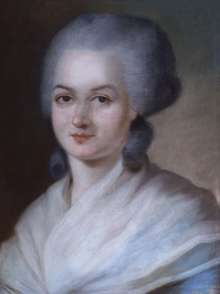Women in the French Revolution
Devance explains the decision in terms of the emphasis on masculinity in wartime, Marie Antoinette's bad reputation for feminine interference in state affairs, and traditional male supremacy.
It inspired movements like New Zealand's suffrage bill and helped shape the foundation of modern feminism, challenging traditional gender roles and advocating for universal equality.
Laws and traditions confined women to work strenuous, labor-intensive jobs, which gave earnings that were significantly lower than men's income, and did not allow rights to improve their status or become masters at their trade.
A woman's education often consisted of learning to be a good wife and mother; thus, women were not supposed to be involved in the political sphere, as the limit of their influence was the raising of future citizens.
[6] The subservient role of women before the revolution was perhaps best exemplified by the Frederician Code, published in 1761 and attacked by Enlightenment philosophers and publications.
Writing several articles on women in society, Louis de Jaucourt criticized traditional roles for women, arguing that "it would be difficult to demonstrate that the husband's rule comes from nature, in as much as this principle is contrary to natural human equality... a man does not invariably have more strength of body, of wisdom, of mind or conduct than a woman...
De Corday d'Armont is a prime example of such a woman: sympathetic to the revolutionary political faction of the Girondists, she assassinated the Jacobin leader, Jean-Paul Marat.
[13] Léon requested permission be granted to women to arm themselves with pikes, pistols, sabers and rifles, as well as the privilege of drilling under the French Guards.
[15] On 20 June 1792, many armed women took part in a procession that "passed through the halls of the Legislative Assembly, into the Tuileries Gardens, and then through the King's residence.
[17] The most radical militant feminist activism was practiced by the Society of Revolutionary Republican Women, which was founded by Léon and her colleague, Claire Lacombe on 10 May 1793.
[28] Olympe de Gouges was one of few public voices to protest the human slave trade and the only woman to openly criticize the government's suspending of the democratic constitution of 1793.
She believed that it was this inferior education that turned them into foolish people, but women "could easily be concentrated and solidified upon objects of great significance" if given a chance.
[32] Though women did not gain the right to vote due to the Revolution, they still greatly expanded their political participation and involvement in government.
A leading example of lasting feminine influence from that time was Madame de Staël (1766–1817) who both witnessed the tumultuous events, participated in, and commented on them.
Many men, including intellectuals, politicians, and activists, were actively involved in various aspects of the revolutionary movement, contributing to its ideological foundations and practical implementations.
He collaborated closely with his wife, Sophie de Condorcet, in advocating for gender equality and women's inclusion in civil and political life.
Their joint efforts, including Sophie's active participation in political discussions and writing, helped to advance the cause of women's rights during this period.
[37] Moreover, male support for the French Revolution extended beyond individuals like Condorcet to include a broader spectrum of intellectuals, politicians, and ordinary citizens.
[42] Economically, many peasant women refused to sell their goods for assignats because this form of currency was unstable and was backed by the sale of confiscated Church property.
In response to this measure, women in many areas began circulating anti-oath pamphlets and refused to attend masses held by priests who had sworn oaths of loyalty to the Republic.
This diminished the social and political influence of the juring priests because they presided over smaller congregations, and counter-revolutionary women did not seek them for baptisms, marriages, or confession.
[44] These women continued to adhere to traditional practices such as Christian burials and naming their children after saints despite revolutionary decrees to the contrary.
[45] It was this determined resistance to the Civil Constitution of the Clergy and the dechristianisation campaigns that played a major role in the re-emergence of the Catholic Church as a prominent social institution.
Olwen Hufton notes about the Counter-Revolutionary women: "for it is her commitment to her religion which determines in the post-Thermidorean period the re-emergence of the Catholic Church...".
[46] Although they struggled, these women were eventually vindicated in their bid to re-establish the Church and thereby also to reestablish traditional family life and social stability.
[47] This act came after years of attempts at dechristianisation or state-controlled religion, which were thwarted in part due to the resistance of religiously devout counter-revolutionary women.




